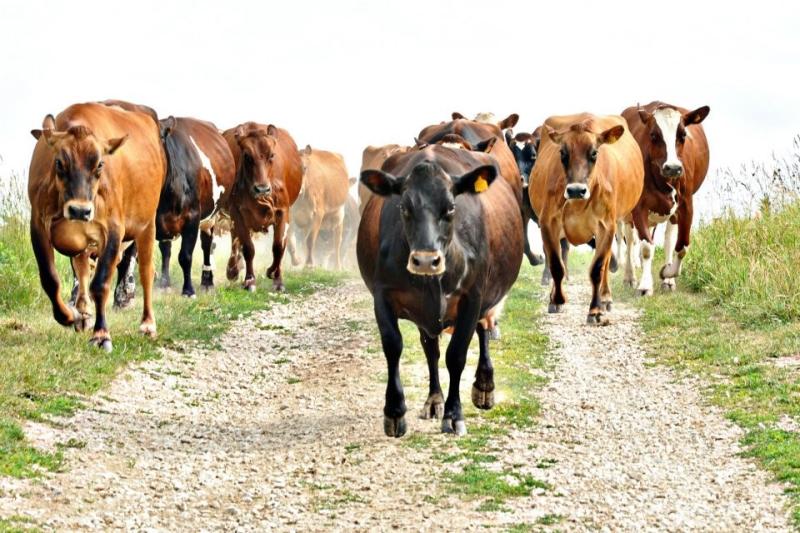What’s the beef with the dairy industry?


Climate change due to human action is one of, it not the most important area of research at this time. Most feel that we need to dramatically reduce our effects on the environment. One area that is often cited as an industry that needs to reduce its’ carbon footprint is the agricultural industry. Having grown up in an agricultural community, on a dairy farm, I have trouble reconciling my great experiences growing in this setting, and the environmental issues attributed to the agricultural industry.
More recently, I have noticed a large number of studies coming out about the greenhouse gases resulting from the beef and dairy industries. I am very familiar with how much food-stuff cattle eat! To make cow-chow, it takes a lot of input into crop production including nutrient inputs and tractor gas...ok diesel, but while we are on the topic of gas, cows make a lot of methane. Methane is a very significant player in greenhouse gas production [1]. It is estimated that 37 percent of human caused methane is produced from domesticated animals, with 2/3 of this resulting of livestock [2], and 1/3 from pets [3].
Methane and other greenhouse gas are problematic. We can do several things to reduce our greenhouse gas production. In addition to reducing our animal product consumption, we can also make animal production and crop production more efficient. One way of doing this is to improve the genetics of both our livestock and crops. Side bar, we can also consider producing in different ways, checkout this TED talk.
Animal breeders are really effective in improving their respective species. Dairy cattle are extremely effective at producing milk. They are just as efficient at producing calories as egg laying hens, and more efficient than pork, poultry, and beef cattle at converting feed to food for human consumption [4]. Often times plant alternatives are suggested as environmentally friendly alternatives, but this is not always true. For example the production of dairy milk uses 1534 less gallons of water per liter of milk relative to almonds [5].
Animal breeders including the dairy industry breeders (since 2009) have improved the genetics of the herd by employing a technique called genomic selection [6]. Using this technique, they use genetic data to predict performance of the progeny in their breeding program, making breeding more efficient. Since implementing genomic selection, they have increased milk production and efficiency. Interestingly, methane production in cattle is a heritable trait. Therefor, they can use genomic selection to make cows less gassy, reducing atmospheric methane through genetics and breeding [2].
Genomic selection is a technique we are beginning to use in plant breeding. The tools and techniques have been made possible because of the animal breeders’ investment in breeding programs from beef, dairy, and swine production. With genomic selection, we hope to improve crop yields to new levels, while at the same time reducing nutrient and pesticide inputs [7].
Genomic selection is something I have had an opportunity to begin to test and observe how effective it could be to breed for disease resistance in soybean. Our current results looks promising, indicating we could improve our breeding efforts through deploying this technique.
There is a lot the agricultural industry can do to improve. Genetics and breeding will be a large part of it. The good news is that agricultural scientist are actively making concerted efforts to reduce environmental impacts, including my favorite area of research, breeding and genetics.
Written By TPS Fellow William Rolling
[1] Schulze, E. D., et al. "Importance of methane and nitrous oxide for Europe's terrestrial greenhouse-gas balance." Nature Geoscience 2.12 (2009): 842.
[2] Pickering, N. K., et al. "Animal board invited review: genetic possibilities to reduce enteric methane emissions from ruminants." Animal 9.9 (2015): 1431-1440.
[3] Okin, Gregory S. "Environmental impacts of food consumption by dogs and cats." PloS one 12.8 (2017): e0181301.
[4] Shepon, Alon, et al. "Energy and protein feed-to-food conversion efficiencies in the US and potential food security gains from dietary changes." Environmental Research Letters11.10 (2016): 105002.
[5]www.ioes.ucla.edu/wp-content/uploads/cow-vs-almond-milk-1.pdf
[6]VandeHaar, M. J., et al. "Harnessing the genetics of the modern dairy cow to continue improvements in feed efficiency1." Journal of dairy science 99.6 (2016): 4941-4954.
[7] Lorenz, Aaron J., et al. "Genomic selection in plant breeding: knowledge and prospects." Advances in agronomy. Vol. 110. Academic Press, 2011. 77-123.
